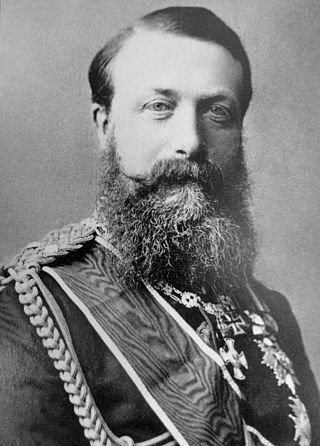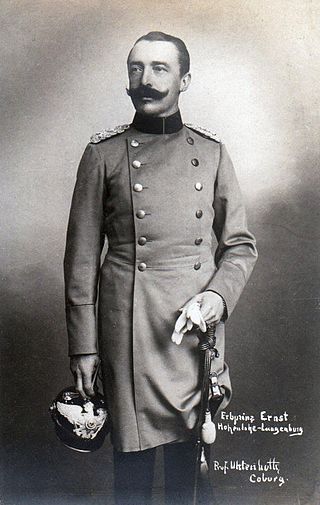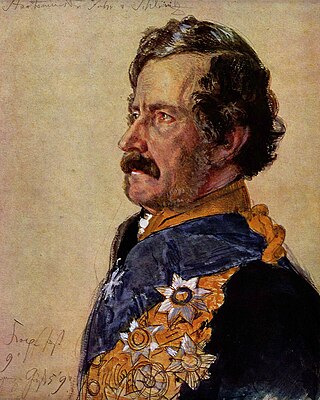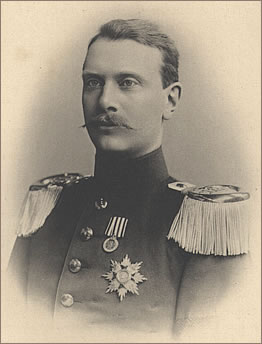
Maximilian, Margrave of Baden, also known as Max von Baden, was a German prince, general, and politician. He was heir presumptive to the throne of the Grand Duchy of Baden, and in October and November 1918 briefly served as the last chancellor of the German Empire and minister-president of Prussia. He sued for peace on Germany's behalf at the end of World War I based on U.S. President Woodrow Wilson's Fourteen Points and took steps towards transforming the government into a parliamentary system. As the German Revolution of 1918–1919 spread, he handed over the office of chancellor to SPD Chairman Friedrich Ebert and unilaterally proclaimed the abdication of Emperor Wilhelm II. Both events took place on 9 November 1918, marking the beginning of the Weimar Republic.

Prince Friedrich Karl Nikolaus of Prussia was the son of Prince Charles of Prussia (1801–1883) and his wife, Princess Marie of Saxe-Weimar-Eisenach (1808–1877). Prince Friedrich Karl was a grandson of King Frederick William III of Prussia and a nephew of Frederick William IV and William I.

Frederick I was the Grand Duke of Baden from 1858 to 1907.

Frederick II was the last sovereign Grand Duke of Baden, reigning from 1907 until the abolition of the German monarchies in 1918. The Weimar-era state of Baden originated from the area of the Grand Duchy of Baden.

Ernst I, Duke of Saxe-Altenburg, was a duke of Saxe-Altenburg. He was the first son of Georg, Duke of Saxe-Altenburg and Marie Luise of Mecklenburg-Schwerin. In 1853 he succeeded his father as Duke of Saxe-Altenburg. He was of a retiring disposition and he took little active part in running the country. After a reign that lasted fifty five years, he died without a living direct male heir; because of this, he was succeeded by his nephew, Ernst.

Prince Aribert Joseph Alexander of Anhalt was regent of Anhalt from September to November 1918 on behalf of his underage nephew Joachim Ernst, Duke of Anhalt. As regent, following the German revolution, he abdicated in the name of his nephew on 12 November 1918, thus ending the rule of the House of Ascania in Anhalt.

Maximilian Karl Lamoral Graf O’Donnell von Tyrconnell was an Austrian officer and civil servant who became famous when he helped save the life of Emperor Franz Josef I of Austria. O'Donnell was a descendant of the Irish noble dynasty of O'Donnell of Tyrconnell.

The House and Merit Order of Duke Peter Frederick Louis or proper German Oldenburg House and Merit Order of Duke Peter Frederick Louis was a civil and military order of the Grand Duchy of Oldenburg, a member state of the German Empire. The order was founded by Grand Duke Augustus of Oldenburg on 27 November 1838, to honor his father, Peter Frederick Louis of Oldenburg. It became obsolete in 1918 after the abdication of the last grand duke.

Prince Konrad of Bavaria was a member of the Bavarian Royal House of Wittelsbach.

Frederick I was a German prince of the house of Ascania who ruled the Duchy of Anhalt from 1871 to 1904.

The Order of the Zähringer Lion was instituted on 26 December 1812 by Karl, Grand Duke of Baden, in memory of the Dukes of Zähringen from whom he was descended.

Ernst, 7th Prince of Hohenlohe-Langenburg was a German aristocrat and Prince of Hohenlohe-Langenburg. He served as the Regent of the Duchy of Saxe-Coburg and Gotha during the minority of his wife's cousin, Duke Charles Edward, from 1900 to 1905.

Alexander Gustav Adolf Graf von Schleinitz was the Foreign Minister of Prussia from 1858 to 1861 and minister for the royal household from late 1861 to his death.

Otto Grafzu Stolberg-Wernigerode was an Imperial German officer, diplomat and politician who served as the first vice-chancellor of the German Empire under Otto Von Bismarck between 1878 and 1881.

Prince Louis William Augustus of Baden was a Prussian general and politician. He was the father of Prince Maximilian of Baden, the last Minister President of the Kingdom of Prussia and last Chancellor of the German Empire. Wilhelm was a Prince of Baden, and a member of the House of Zähringen.

The House Order of Henry the Lion In German: Hausorden Heinrichs des Löwen, was the House Order of the Duchy of Brunswick. It was instituted by William VIII, Duke of Brunswick on 25 April 1834. The ribbon of the Order was red with yellow edges. It had five grades: Grand Cross, Grand Commander with Sash, Commander, Knight 1st Class, Knight 2nd Class, plus Medal of Merit for Science and Arts, the Cross of Merit and the Medal of Honour. The Order was named in honour of Henry the Lion, who remains a popular figure to this day.

The Order of Merit of Philip the Magnanimous was an order of chivalry established by Louis II, Grand Duke of Hesse on 1 May 1840, the name day of Philip I, Landgrave of Hesse, in his honour to award extraordinary military or civil merit. It was the second-highest order of the Grand Duchy of Hesse before 1876, when it was displaced to third by the revived Order of the Golden Lion, the former paramount order of the Electorate of Hesse.

The House Order of Fidelity is a dynastic order of the Margraviate of Baden. It was established by Charles III William, Margrave of Baden-Durlach as a reward for merit and to mark the laying of the foundation stone of his residence at Karlsruhe Palace. As was customary at that time, it was originally named in French as the Ordre de la Fidélité, before later being renamed the Orden der Treue and finally in 1840 the Hausorden der Treue. Its motto was Fidelitas, which is also part of Karlsruhe, Germany's coat of arms.

Prince Heinrich of Hesse and by Rhine was a member of the House of Hesse-Darmstadt and a General of the Cavalry.
Friedrich Bernhard Karl Gustav Ulrich Erich Graf von der Schulenburg was a Prussian General during World War I and a member of the Nazi Party during the inter-war period.





















